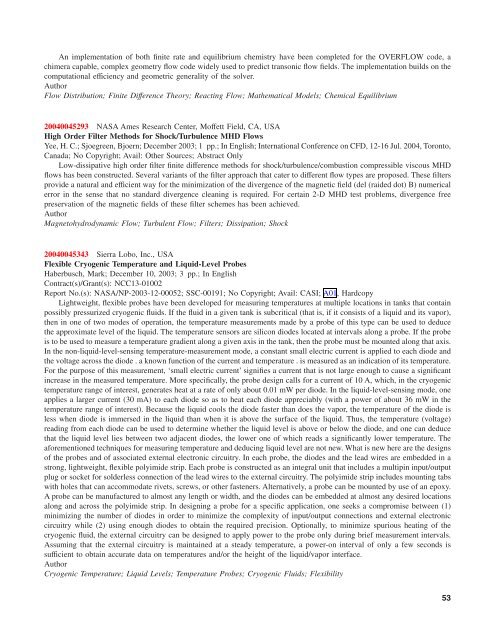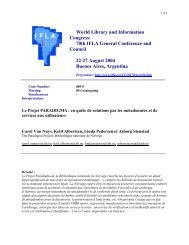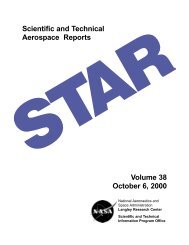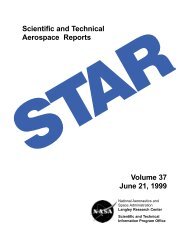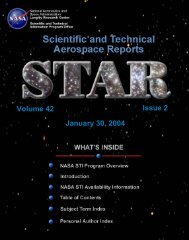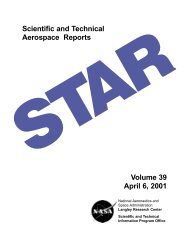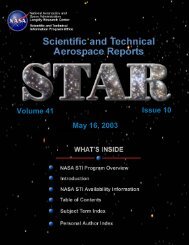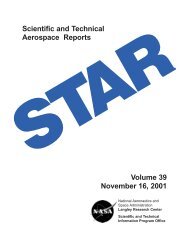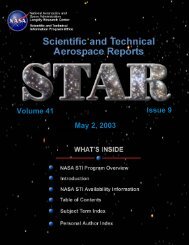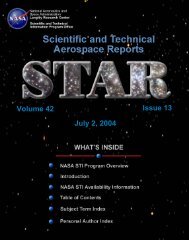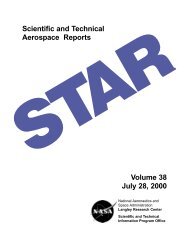NASA Scientific and Technical Aerospace Reports
NASA Scientific and Technical Aerospace Reports
NASA Scientific and Technical Aerospace Reports
Create successful ePaper yourself
Turn your PDF publications into a flip-book with our unique Google optimized e-Paper software.
An implementation of both finite rate <strong>and</strong> equilibrium chemistry have been completed for the OVERFLOW code, a<br />
chimera capable, complex geometry flow code widely used to predict transonic flow fields. The implementation builds on the<br />
computational efficiency <strong>and</strong> geometric generality of the solver.<br />
Author<br />
Flow Distribution; Finite Difference Theory; Reacting Flow; Mathematical Models; Chemical Equilibrium<br />
20040045293 <strong>NASA</strong> Ames Research Center, Moffett Field, CA, USA<br />
High Order Filter Methods for Shock/Turbulence MHD Flows<br />
Yee, H. C.; Sjoegreen, Bjoern; December 2003; 1 pp.; In English; International Conference on CFD, 12-16 Jul. 2004, Toronto,<br />
Canada; No Copyright; Avail: Other Sources; Abstract Only<br />
Low-dissipative high order filter finite difference methods for shock/turbulence/combustion compressible viscous MHD<br />
flows has been constructed. Several variants of the filter approach that cater to different flow types are proposed. These filters<br />
provide a natural <strong>and</strong> efficient way for the minimization of the divergence of the magnetic field (del (raided dot) B) numerical<br />
error in the sense that no st<strong>and</strong>ard divergence cleaning is required. For certain 2-D MHD test problems, divergence free<br />
preservation of the magnetic fields of these filter schemes has been achieved.<br />
Author<br />
Magnetohydrodynamic Flow; Turbulent Flow; Filters; Dissipation; Shock<br />
20040045343 Sierra Lobo, Inc., USA<br />
Flexible Cryogenic Temperature <strong>and</strong> Liquid-Level Probes<br />
Haberbusch, Mark; December 10, 2003; 3 pp.; In English<br />
Contract(s)/Grant(s): NCC13-01002<br />
Report No.(s): <strong>NASA</strong>/NP-2003-12-00052; SSC-00191; No Copyright; Avail: CASI; A01, Hardcopy<br />
Lightweight, flexible probes have been developed for measuring temperatures at multiple locations in tanks that contain<br />
possibly pressurized cryogenic fluids. If the fluid in a given tank is subcritical (that is, if it consists of a liquid <strong>and</strong> its vapor),<br />
then in one of two modes of operation, the temperature measurements made by a probe of this type can be used to deduce<br />
the approximate level of the liquid. The temperature sensors are silicon diodes located at intervals along a probe. If the probe<br />
is to be used to measure a temperature gradient along a given axis in the tank, then the probe must be mounted along that axis.<br />
In the non-liquid-level-sensing temperature-measurement mode, a constant small electric current is applied to each diode <strong>and</strong><br />
the voltage across the diode . a known function of the current <strong>and</strong> temperature . is measured as an indication of its temperature.<br />
For the purpose of this measurement, ‘small electric current’ signifies a current that is not large enough to cause a significant<br />
increase in the measured temperature. More specifically, the probe design calls for a current of 10 A, which, in the cryogenic<br />
temperature range of interest, generates heat at a rate of only about 0.01 mW per diode. In the liquid-level-sensing mode, one<br />
applies a larger current (30 mA) to each diode so as to heat each diode appreciably (with a power of about 36 mW in the<br />
temperature range of interest). Because the liquid cools the diode faster than does the vapor, the temperature of the diode is<br />
less when diode is immersed in the liquid than when it is above the surface of the liquid. Thus, the temperature (voltage)<br />
reading from each diode can be used to determine whether the liquid level is above or below the diode, <strong>and</strong> one can deduce<br />
that the liquid level lies between two adjacent diodes, the lower one of which reads a significantly lower temperature. The<br />
aforementioned techniques for measuring temperature <strong>and</strong> deducing liquid level are not new. What is new here are the designs<br />
of the probes <strong>and</strong> of associated external electronic circuitry. In each probe, the diodes <strong>and</strong> the lead wires are embedded in a<br />
strong, lightweight, flexible polyimide strip. Each probe is constructed as an integral unit that includes a multipin input/output<br />
plug or socket for solderless connection of the lead wires to the external circuitry. The polyimide strip includes mounting tabs<br />
with holes that can accommodate rivets, screws, or other fasteners. Alternatively, a probe can be mounted by use of an epoxy.<br />
A probe can be manufactured to almost any length or width, <strong>and</strong> the diodes can be embedded at almost any desired locations<br />
along <strong>and</strong> across the polyimide strip. In designing a probe for a specific application, one seeks a compromise between (1)<br />
minimizing the number of diodes in order to minimize the complexity of input/output connections <strong>and</strong> external electronic<br />
circuitry while (2) using enough diodes to obtain the required precision. Optionally, to minimize spurious heating of the<br />
cryogenic fluid, the external circuitry can be designed to apply power to the probe only during brief measurement intervals.<br />
Assuming that the external circuitry is maintained at a steady temperature, a power-on interval of only a few seconds is<br />
sufficient to obtain accurate data on temperatures <strong>and</strong>/or the height of the liquid/vapor interface.<br />
Author<br />
Cryogenic Temperature; Liquid Levels; Temperature Probes; Cryogenic Fluids; Flexibility<br />
53


